Mariachi musicians knew her as “La Grandota,” while the media often referred to her as the “Mariachi Queen.” At 6-foot-one (1.85 meters), her presence was larger than life. As a mariachi musician, educator, researcher and tireless promotor of the genre, she left an indelible mark on the U.S. mariachi scene. On the fifth anniversary of her passing, mariachimusic.com pays a well-deserved tribute to Laura Garciacano Sobrino.
Early history
Laura Ann García was born on September 25, 1954 in the central coast agricultural town of Watsonville, California. In elementary school she began studying the violin. “The first moment I held a violin, I knew this was the instrument I was meant to play,” she said in a 1998 Fiddler magazine interview. In high school she became the concertmistress of the Santa Cruz County Youth Symphony, and upon graduation in 1972 she was awarded a scholarship to study music at the University of California’s Santa Cruz campus.
Although her father was born in Mexico and her mother was the daughter of Mexican immigrants, Laura’s parents rarely spoke to her and her brother in Spanish. It wasn’t until entering college that she became acutely aware that most of her Hispanic classmates were more fluent in Spanish than she was. This prompted Laura to take a year off from school to live in Mexico, where she perfected her language skills and reinforced her ethnic identity. She later changed her last name to “Garciacano” to restore the ancestral surname that had been abbreviated to “García” when her father immigrated to the U.S.
Returning to UC Santa Cruz in 1975, Laura was browsing the catalog of classes when she spotted a course titled Music of Mexico. She signed up, and it changed the course of her life. Until then, she hadn’t taken any serious interest in Mexican music or attempted to play it.
The class was taught by UCLA ethnomusicologist David Kilpatrick, who had been a member of his alma mater’s student ensemble, Mariachi Uclatlán. The class covered jarocho, huasteco, norteño, and mariachi regions. Of these, the one that most caught Laura’s attention was that of mariachi. She soon joined Mariachi Los Caltecas, an extracurricular group led by her professor.
Mariachi Uclatlán
Laura soon became Dr. Kilpatrick’s star student and distinguished herself as one of Los Caltecas’ most talented and enthusiastic members. In 1978, word of her got to Mark Fogelquist, director of Mariachi Uclatlán, who invited Laura to his group. By this time, Mariachi Uclatlán had become independent of the University of California at Los Angeles and was a popular professional ensemble.
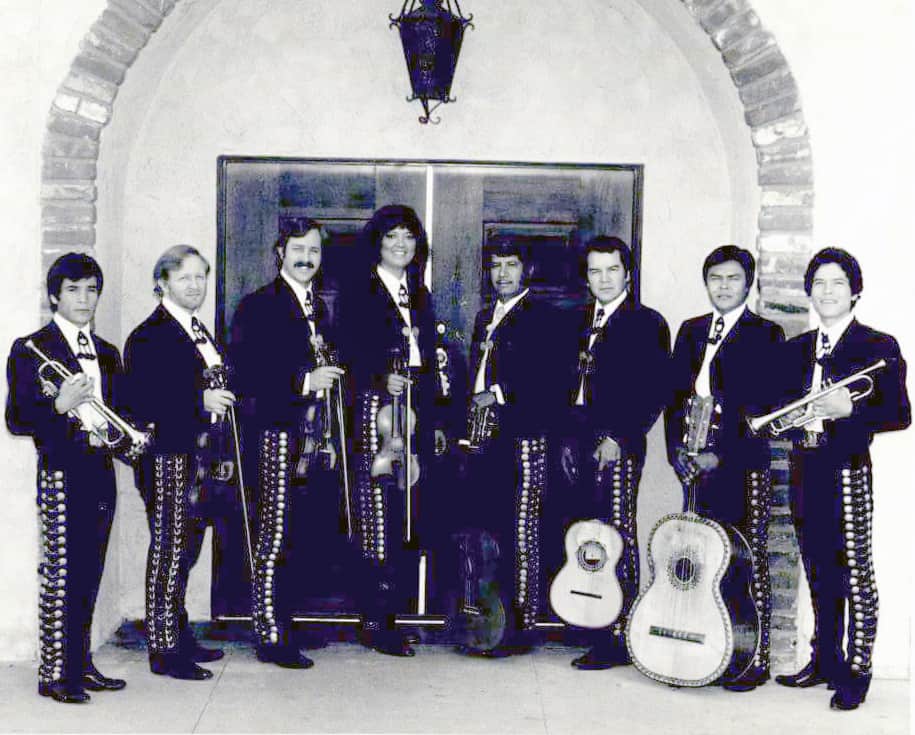
Pedro Piña, Lawrence Saunders, Mark Fogelquist, Laura Garciacano, Manuel Vaca, Víctor Romero, Raúl Garibay, Samuel Nolasco.
(photo courtesy of Mark Fogelquist)
Mariachi Los Galleros
After a year with Mariachi Uclatlán and eight months with Mariachi Nuevo Uclatlán, in 1980 Laura was invited to join the legendary Mariachi Los Galleros de Pedro Rey. Los Galleros had never previously had a female member, and the invitation was in clear response to the fact that Mariachi Los Camperos de Nati Cano — Los Galleros’ main rival — currently had a woman in their group: Rebecca Gonzales.

Regino Almaguer, Felipe Pérez “el Pichi,” Beatriz Adriana, Laura Garciacano, Pedro Rey, Pedro Flores, Juan José Almaguer, José Arellano.
(photo courtesy of Nancy Muñoz)
Return to Los Caltecas
After two years with Mariachi Los Galleros, Laura left that group to marry her former professor, David Kilpatrick, who was 15 years her senior. She returned to Santa Cruz to live with her husband and rejoined her old group, Mariachi Los Caltecas. Los Caltecas had more clientele than it did when she had left four years previous, but artistically, it turned out to be an exercise in frustration for her. “After having worked with major groups in Los Angeles, Los Caltecas represented a major step backwards for Laura,” affirms her ex-bandmate Timoteo “Tello” González.
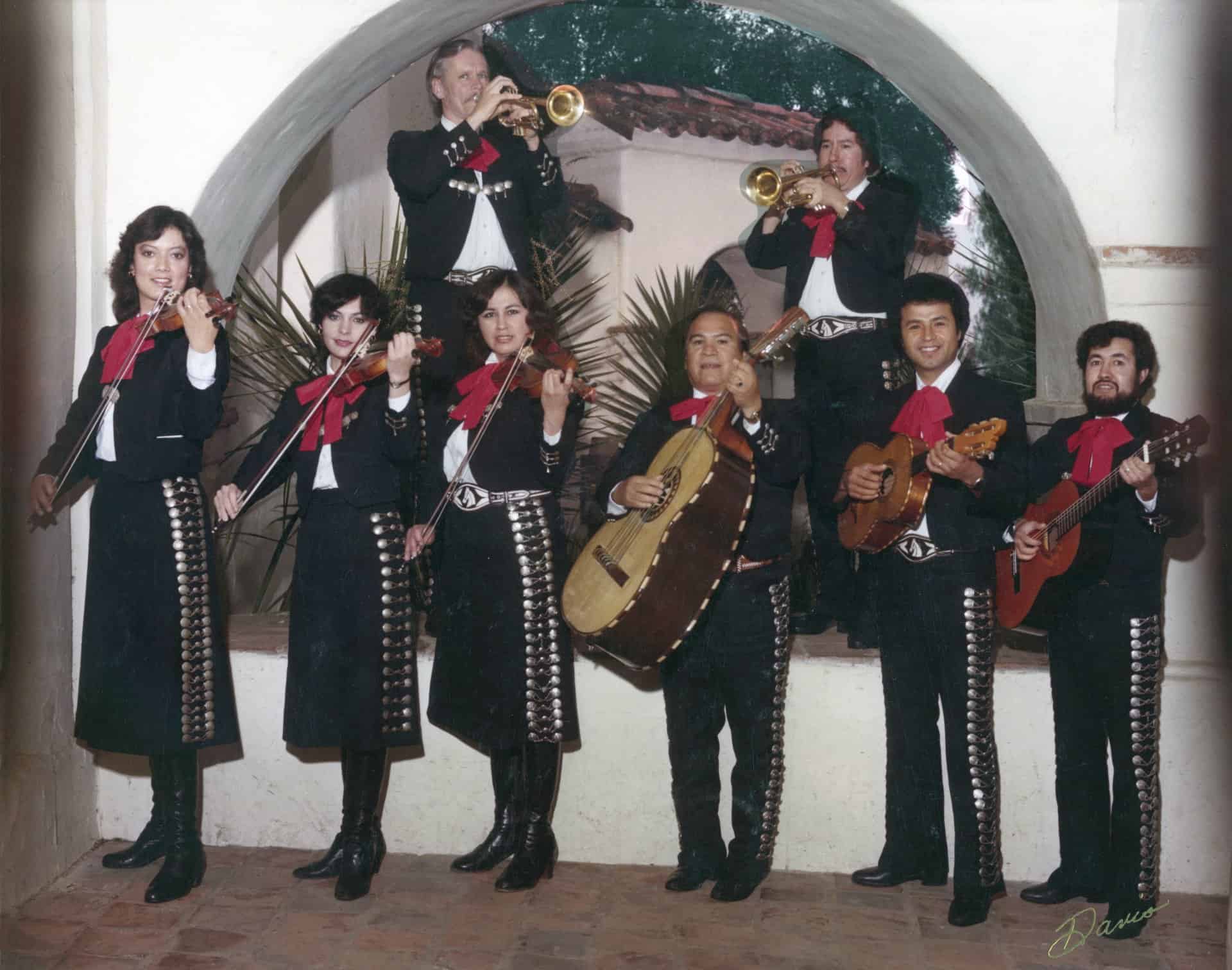
Above: David Kilpatrick, José Guerrero.
Below: Laura García, Kate Woods, Bárbara Díaz, Juan Fernández, Javier Vargas, Álvaro González.
(photo courtesy of Jonathan Clark)
Mariachi Sol de México
When José Hernández, who had played together with Laura in Los Galleros, invited her to join a new mariachi he was forming to be the house band at a new restaurant he was opening, it wasn’t surprising that she accepted his offer. On August 30, 1986, Laura made her debut as a member of Mariachi Sol de México at the inauguration of Cielito Lindo Restaurant, located in South El Monte, California.
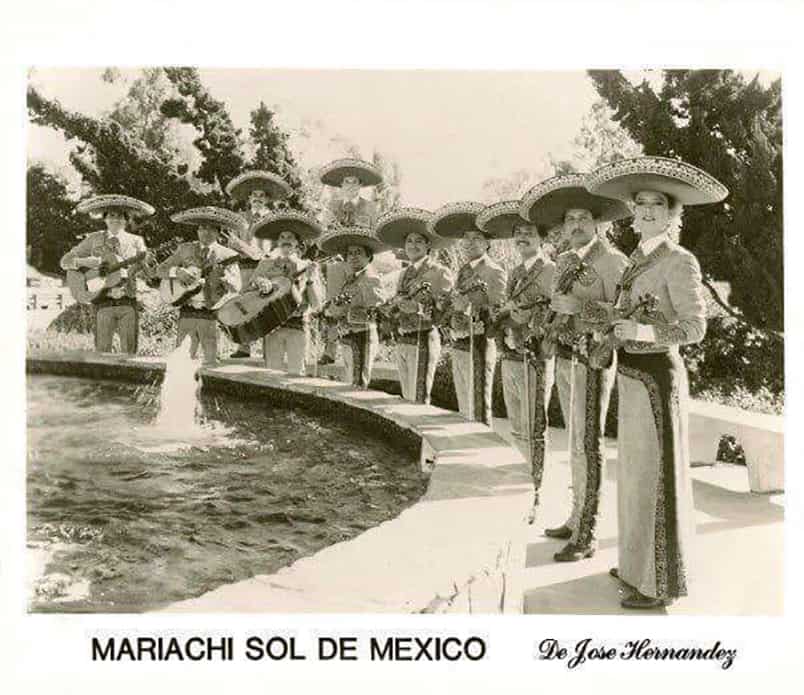
Abajo: Jesús Hernández, Timoteo González, Filiberto Ramírez, Valente Enzaldo, Ramon Rodríguez, Mario Rodríguez, Juan de Dios Nóperi, Felipe Romero, Laura Garcia.
(photo courtesy of José Hernández)
It was in Sol de México that Laura first came to musical maturity. She liked to tell the story of how she had a musical epiphany one night while playing on stage with the group, where certain concepts of bowing and phrasing that had previously eluded her suddenly became clear. Laura became a prolific transcriber of mariachi arrangements, which she published through Keiser Southern Music, Mel Bay Publications, and her own Mariachi Publishing Company.
Professor Kilpatrick followed his wife to the Los Angeles area, where he got a teaching job at a high school and where the two shared a house. After a year or so, however, the marriage fell apart and they divorced. Nonetheless, Laura never ceased to credit David as her principal mentor. As Cynthia Reifler Flores quotes Sobrino in her 2013 California State University at Los Angeles master’s thesis: “No question. David Kilpatrick. Absolutely. Without a doubt. On everything. You know, he’s the one that really prepared me for LA.”
Mariachi Imperial de México
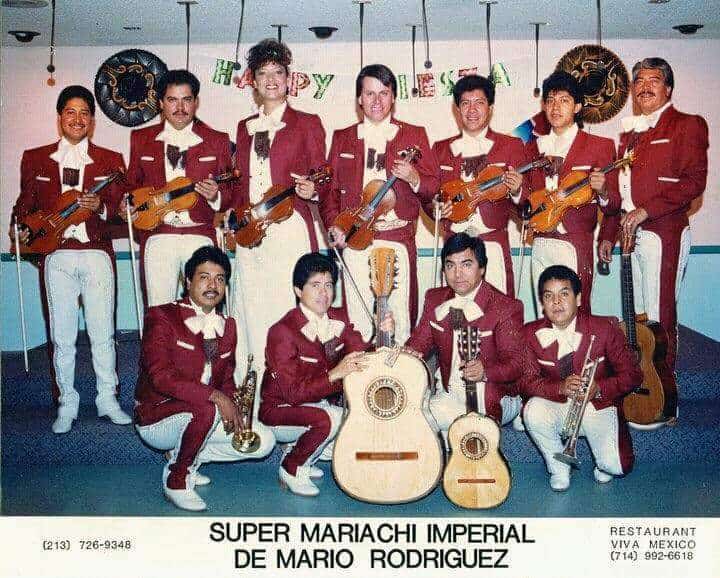
Front row: Martín Lara “El Ánimas”, Ángel Aguayo, Timoteo González “Tello”, Juan Pérez.
(photo courtesy of Mario Rodríguez)
In Mariachi Sol de México, Laura shared the first violin chair with renowned violinist Mario Rodríguez “El Mono.” In the summer of 1989, the two violinists, along with several other group members, left Sol de México to form the house band at a new restaurante in the town of Fullerton, about 25 miles from Cielito Lindo, called ¡Viva México! The new group, named Mariachi Imperial de México, went on to have considerable fame in its own right.
Family
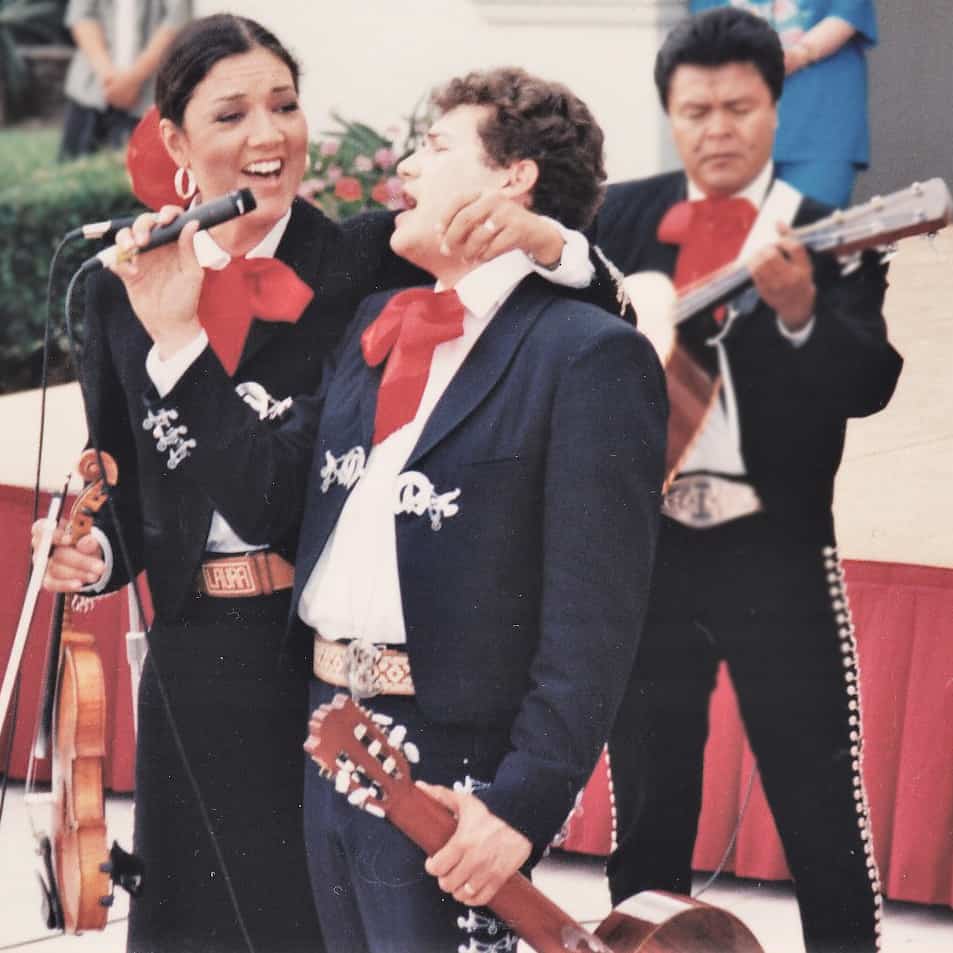
Guitarrón: Raúl Garibay
(photo by Gilbert Martínez)
In June of 1990, Laura began dating a Yucatecan musician by the name of Dan Sobrino. They were listening to mariachis at the Carnitas Uruapan restaurant in Tijuana when Dan proposed to Laura. Three months later, on Mexican Independence Day, the two were married. They had two children, whom they baptized with the Mayan names Nicté and Nazul. Although both are musicians, neither one plays mariachi music. The marriage lasted 24 years, until Laura’s unfortunate demise.
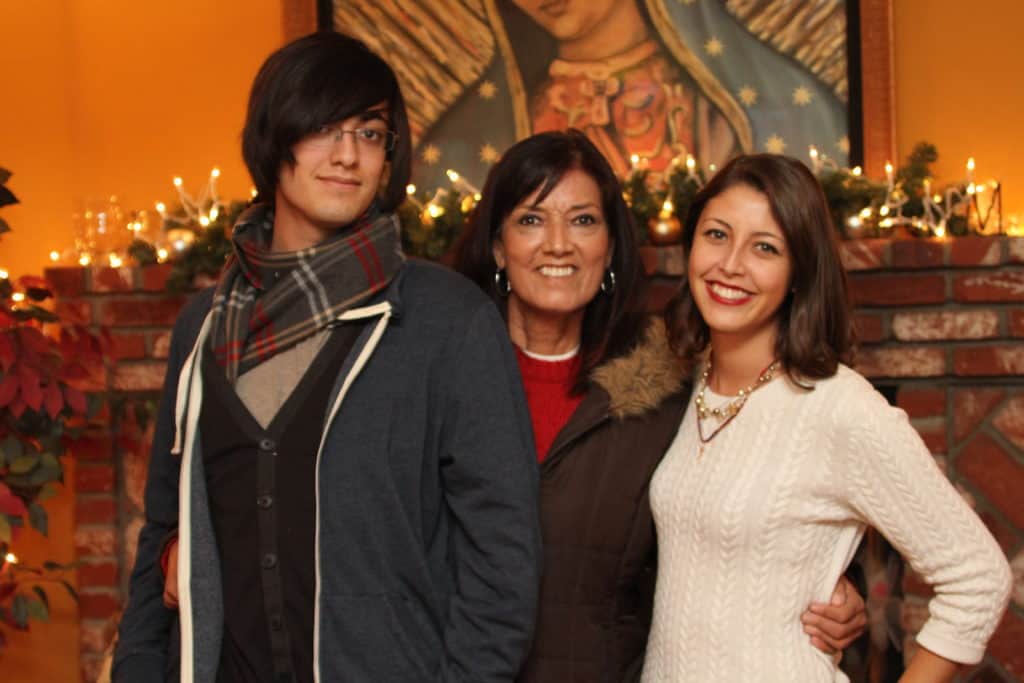
(photo by Gilbert García)
In 1991, after two years with Mariachi Imperial de México, Laura returned to Mariachi Sol de México for a brief sojourn. She soon retired from the stage, however, to accept a position with José Hernández’s newly inaugurated Mariachi Heritage Society, a non-profit organization that teaches mariachi music to Los Angeles-area youth for free or at a minimal cost. Laura became the program’s coordinator, in addition to teaching violin at that school.
Mariachi Reyna de Los Ángeles
In June of 1993, José Hernández shared with Laura his vision of forming an all-female mariachi. Mariachi Las Perlitas Tapatías had become the rage and was headlining mariachi festivals all over the country, but their musical level was quite modest. José clearly saw an opportunity. “He said that he didn’t know anyone else who would be able to direct the female group and asked me if I would be interested,” Laura later explained to me in an e-mail. Laura accepted and began recruiting talent for this new mariachi femenil. The name that José chose for the group was based on the original designation of the Spanish settlement that grew into the metropolis we know today: “El Pueblo de Nuestra Señora la Reyna [sic] de los Ángeles.” Mariachi Reyna de Los Ángeles holds the distinction of being the first stellar all-female mariachi in the United States.
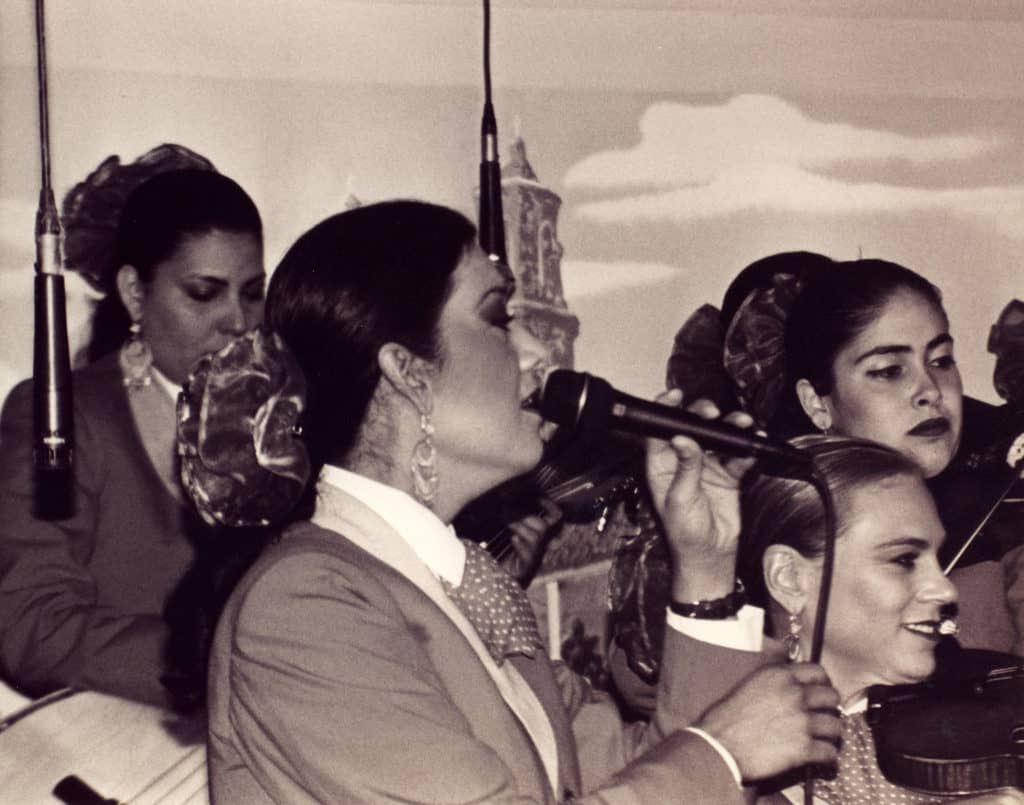
Marisa Orduño, Laura Sobrino, Cynthia Reifler, Rocío Fregoso.
(photo by Gilbert Martínez)
José Hernández was the official founder and musical director of Mariachi Reyna de Los Ángeles, while Laura assumed the unofficial role of coordinator and sub-director. But since she considered herself a co-founder of the group, she felt she was entitled to more authority than José was willing to grant her. Tension built up between the two until, two years after the founding of the group, Laura was fired by José. Laura took the termination quite personally, and wouldn’t even speak to Hernández for several years after that.
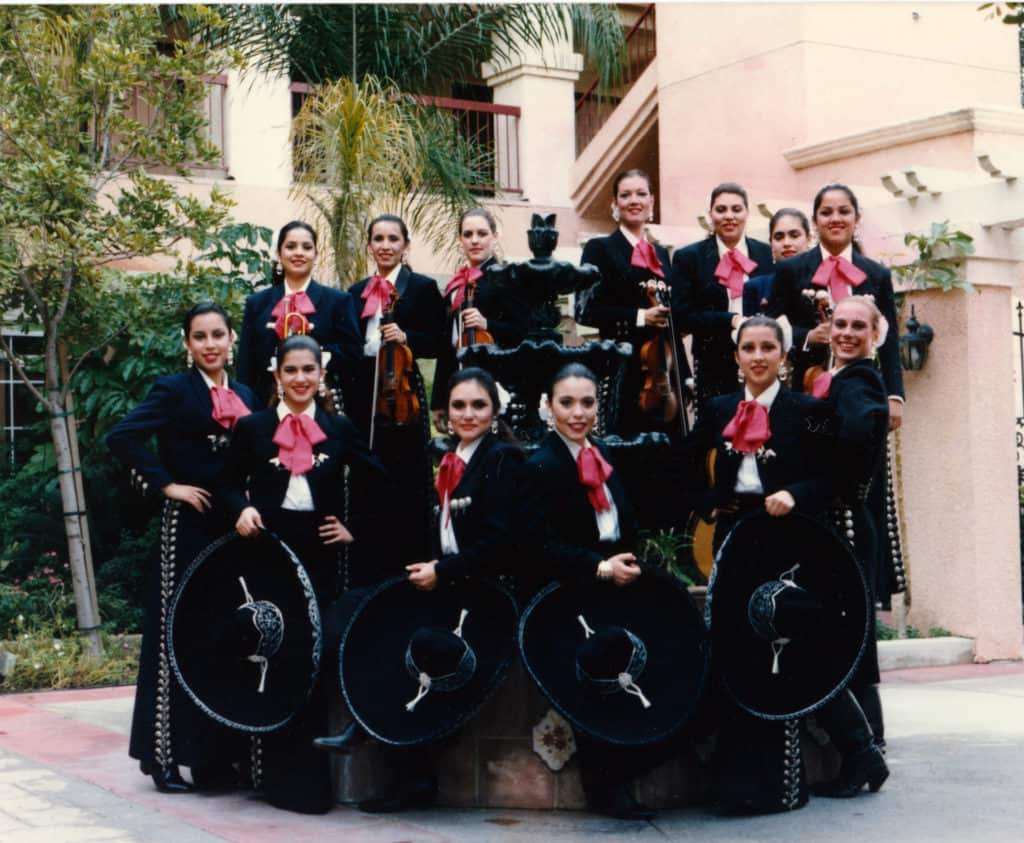
Top row: Griselda Burruel, Catherine Marín Baeza, Chandra Allen, Laura Garciacano Sobrino, Marisa Orduño, Rocío Fregoso, Sylvia Hinojosa.
Bottom row: Nydia Rojas, Patricia Martin, Dolores Nóperi, Theresa Chávez, Espy Donlucas Hernández, Cynthia Reifler Flores.
(photo courtesy of Chandra Allen)
Mariachi USA
Fortunately, Laura never had a shortage of work. One festival she participated in yearly was Rodri Rodríguez’s Mariachi USA at the Hollywood Bowl. In 2014, she became the first woman to direct the festival’s grand finale. Event director Anthony Medrano considers Laura the “crown jewel” of all the females who participated in that festival:
She was the complete package. She could sing. She could play. She could teach and direct. She was also a gifted leader. Laura was always making sure that everyone who shared the stage with her was presenting the best of themselves. From microphone positions to spacing of the ensemble, she made sure that the audience saw the best representation of mariachi music.
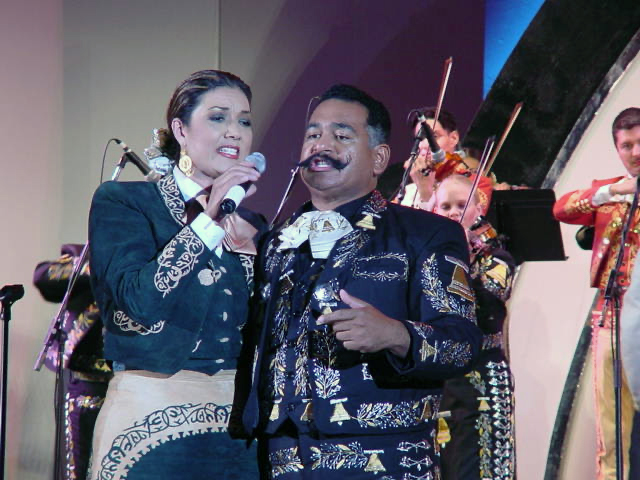
(photo courtesy of Anthony Medrano)
Mariachi Los Palmeros
Laura had played in Mariachi Sol de México with trumpeter Juan Manuel Macías “El Muñeco,” and in 1998 she began a decade-long tenure in his ensemble, Mariachi Los Palmeros. She had an agreement with him that she could miss work whenever she had a festival or an engagement with an all-female group. Juan Manuel comments:
Laura was my right hand. She was a big attraction and added a lot to the mariachi. Long after she left, customers continued to ask for her. To this day, on account of Laura, I feel obligated to always have a female in the group.
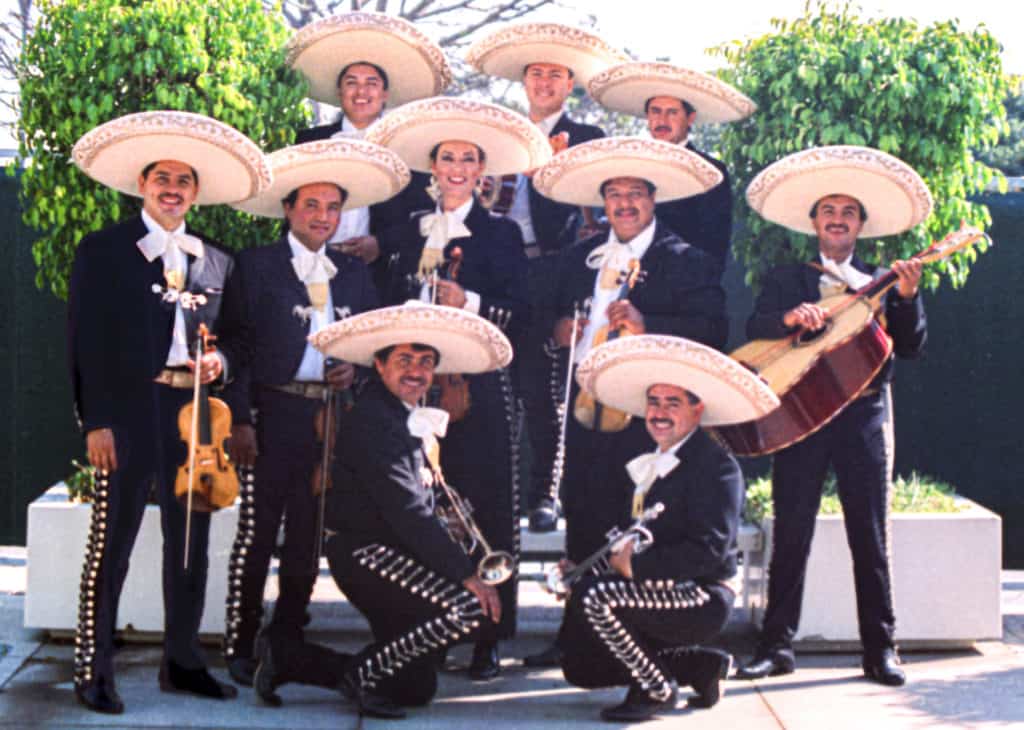
Back row: José Cervantes “El Copetón,” Sergio Alcaraz, Fernando Navarro.
Center row: Santos Becerra, Miguel González, Laura Sobrino, Felipe “Pichi” Pérez.
Kneeling: Roberto Díaz, Sr. & Juan Manuel Macías “El Muñeco.”
(photo by Gilbert Martínez)
Mariachi Mujer 2000
In 1999, Laura became a founding member of Mariachi Mujer 2000—the first all-female mariachi show group in the U.S. to be organized and directed exclusively by women. Marisa Orduño, guitarrón player and the group’s founder, had played with Laura since the early days of Reyna de Los Ángeles. Marisa explains why she invited Laura to the group:
When it came time to decide who to invite as musical director, I didn’t have to think twice—I knew Laura was the ideal person. She had played with a lot of important mariachis and had a lot of musical authority.
Laura wasn’t one of those who just plays the notes superficially. She paid attention to tiny details of style and interpretation that give authenticity to a piece and take a group to the next level. She was always trying to learn subtle secrets from the very best musicians. Not only was she a master of the traditional, but she was up to date with the most modern. She knew all the latest repertoire by Sol, Camperos, Nuevo Teca, Vargas…
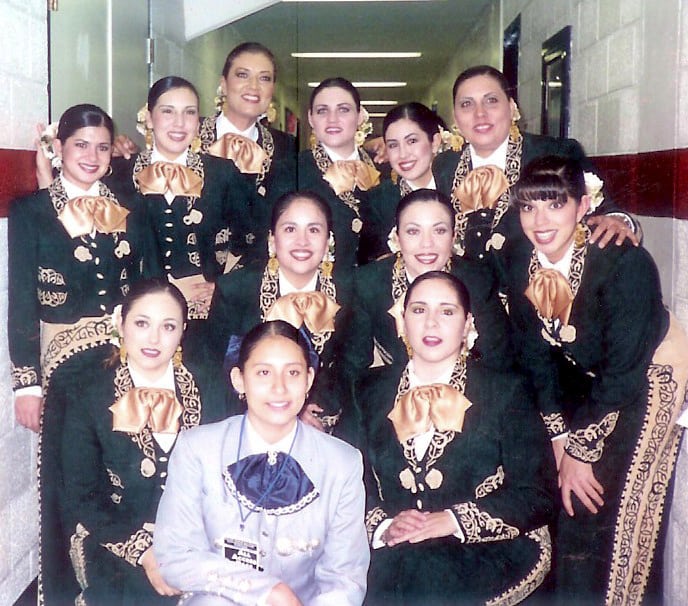
Top row: Patricia Martin, Celia Leyva, Laura Sobrino, Megan Starks, Suemy González, Marisa Orduño.
Middle row: Lucero Delgado, Theresa Chávez, Griselda Pérez.
Bottom row: Lubella Gauna, Annisette Nóperi, Melinda Salcido.
(photo courtesy of Lucero Delgado)
Laura and Rebecca
The careers of Laura Sobrino and Rebecca Gonzales, who both play violin and sing, have multiple parallels. Although Rebecca is from San José, only an hour’s drive from Laura’s native Watsonville, the two never met until Gonzales was already a member of Los Camperos de Nati Cano, which she joined in 1976. Rebecca was an early role model for Laura, who liked to watch her perform with Los Camperos at La Fonda restaurant. Whereas Rebecca had been initiated into mariachi music by Mark Fogelquist in 1972, Laura was initiated by David Kilpatrick in 1975. Both men had been classmates at the UCLA Department of Ethnomusicology, and both were members of Mariachi Uclatlán when it was still a student ensemble. In 1974, Rebecca became the first female to enter a high-profile mariachi group—which Uclatlán had now become—and in 1978 Laura became the second female to do so. Both were invited to that group by its leader, Mark Fogelquist. In 2004, the two women played together for a year in Mariachi Mujer 2000, the same year that both were inducted into the Tucson International Mariachi Conference’s Hall of Fame. (Laura was posthumously inducted into Albuquerque’s Mariachi Spectacular Hall of Fame in 2019.)
Whereas Rebecca is best known for her exquisite singing, Laura is best known as a mariachi educator and musical director, notwithstanding that Gonzales also has been musical director of her own group, Mariachi Tesoro, for the past seven years. Another distinction between the two is that Laura tried her hand at artist management, something Rebecca has yet to attempt.
Rebecca comments:
Laura Sobrino was a good friend and mariachi colleague who dedicated her life to this music as a performer, transcriber, and teacher. I will always be in awe of her ability to raise a family, perform full-time as a mariachi musician, manage her website, and teach. She was truly special, and I miss her. 💔
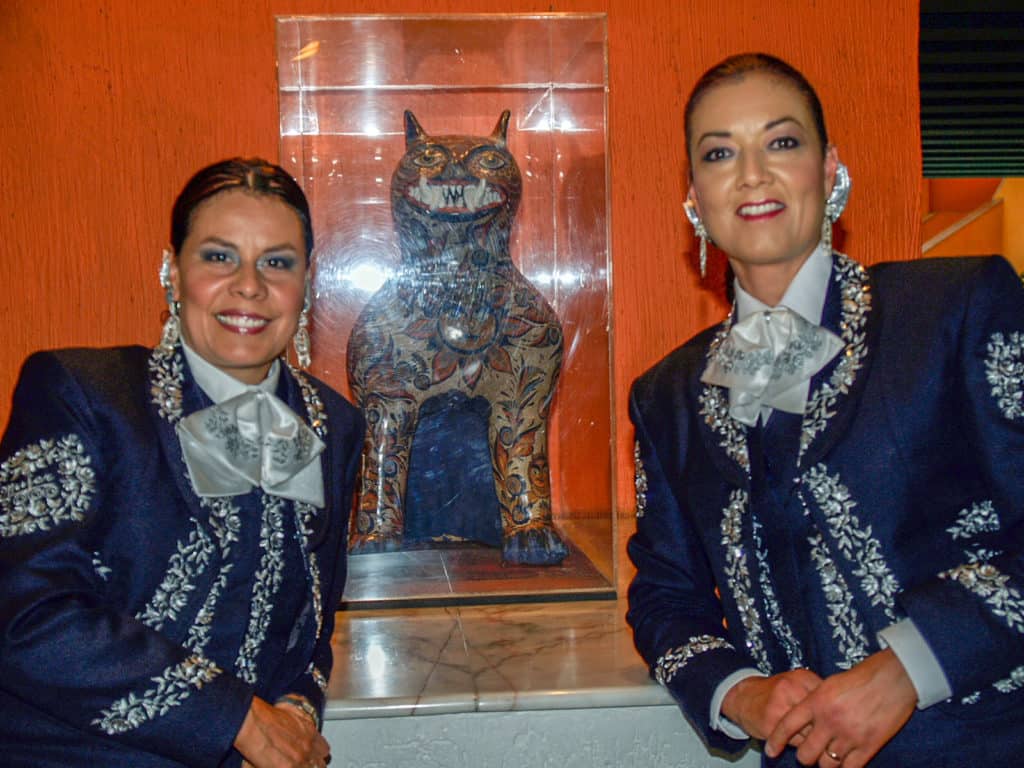
(photo courtesy of Nancy Muñoz)
Laura the researcher
Laura received her introduction to ethnomusicology as a music student at the University of California at Santa Cruz, where she wrote a senior thesis on the mariachi violin, and through her association with ethnomusicologist David Kilpatrick. Although her only formal training was at the undergraduate level, her goal was to someday enter a master’s program in ethnomusicology. This plan was delayed by her career and by motherhood, and ultimately thwarted by her untimely death.
Laura always had an inordinate interest in the female participation in mariachi music, and her plan was to travel to Mexico to do graduate research on this topic as soon as her children were grown. In the meantime, she found a research partner that she could collaborate with while fulfilling her family obligations.
In a blog dated 2007, Laura describes a luncheon reencounter with Leonor Xóchitl Pérez, whom Laura had originally met in 1978 when Leonor was still in high school:
During that lunch, we discovered we had something in common, an interest to document a history of women in mariachi music. We agreed to work together, the “perfect” team; she was a scholar with experience in mariachi performance, and I, a pioneer mariachi with a B.A. in ethnomusicology, specializing in Mexican folk music.
The two agreed to collaborate, and in 1998 they launched the website History of Women in Mariachi Music, the first of its type. In 2002 Nancy Muñoz—who specializes in video, audio, photography and web design—joined the team. Nancy would remain Laura’s best friend until the end of her life. The trio presented several lectures, an exhibit, and a booklet related to the history of women in the mariachi.

(photo courtesy of Nancy Muñoz)
In August of 2007, Laura and Nancy traveled to Mexico City to meet with a group of elderly female mariachi musicians who had been pioneers in their genre. By this time, a considerable amount of tension had developed between Laura and Leonor, due to fundamental differences in methodology. Leonor had a doctorate in education and insisted on strict adherence to the ethnographic research techniques she had learned in graduate school, whereas Laura was more of an intuitive ethnomusicologist, and she found it difficult to view things from Leonor’s perspective. Laura didn’t want Leonor to participate in the Mexico City trip, since she wanted to use this research for her own graduate thesis. Although Leonor found out about the trip and showed up later on her own, she wasn’t invited to take part in the project. The “perfect” team was showing signs of strain.
Mariachólogo Antonio Covarrubias, their contact in Mexico City, picked up Laura and Nancy from the airport and arranged a meeting with the female pioneers. “When I first heard the women play together, it sounded so beautiful that I got the idea to organize them into a group,” Laura recalled. She named the group “Las Pioneras de México,” and promoted them at numerous U.S. mariachi festivales. A German filmmaker even made a documentary film on these pioneer women. Antonio Covarrubias considers Las Pioneras de México to be Laura’s greatest contribution as a mariachi researcher.
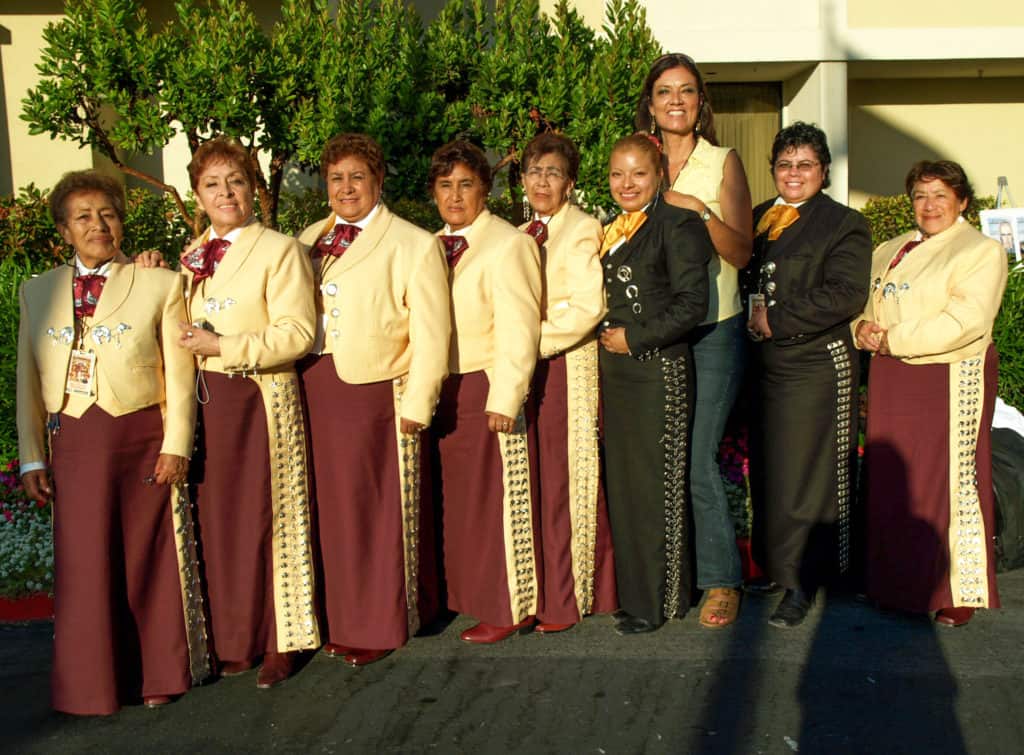
Conchita González, Malena Berrones, María de Jesús Lara, Chabela López, Beatriz Hernández, Laura Sobrino, Martha López, Lupe Villa.
(photo by Nancy Muñoz)
The final collaboration of the research triumvirate was the 2013 exhibit ¡Viva el Mariach Femenil! at the Women’s Museum of California. Laura and Nancy continued to collaborate as a duo, but Laura’s health had become precarious by this time and they produced little. Nancy still administrates the mujeresenelmariachi.com website, which contains the work of the three researchers.
Laura the educator
Laura had a true vocation as an educator. The list of people, male and female, who profess to be taught or inspired by her is almost interminable. During her four-decade career she taught at over a dozen schools, countless festivals and workshops, and for five years at the Mariachi Heritage Society.
When Laura observed talent in a student, she would encourage and cultivate that talent, then she would accommodate that student in a group or find them work among her extensive contacts. Her generosity knew no bounds. To those who worked or studied with her, she was more like a family member than a fellow band member or a teacher. Lucero Delgado gives testimony to this:
Laura gave me my first mariachi instruction at North Ranchito Elementary School in Pico Rivera when I was 13 years old. One day she said to my mom, “Your daughter is learning very quickly. I want to send her to the Mariachi Heritage Society at Third and Indiana streets in East LA,” where she was also giving classes. I met a lot of important people at that school, like my voice teacher, Heriberto Molina. Then I got to go to Laura’s house several times a week to rehearse with Mariachi Juvenil Sol de México, and she would take me to gigs with other groups. She helped me make important connections in the mariachi world, and she eventually invited me to Mariachi Mujer 2000.
Laura helped me with my education as well. All through high school, she would correct grammatical errors on my essays. The last paper she helped me with was my thesis, when I was getting my master’s degree in education.
Laura was a loving, giving person. She would help anybody. If you ever needed anything, she was there for you. She would never say no. She left a huge mark on my life.
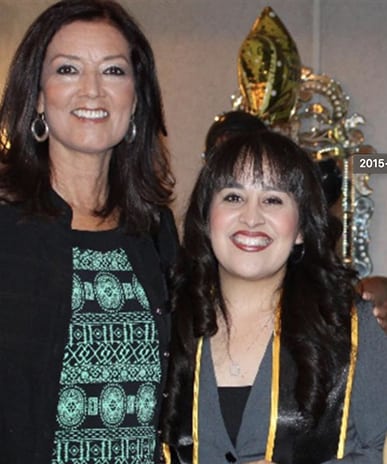
(photo courtesy of Lucero Delgado)
Andrés González of Mariachi Vargas de Tecalitlán explains the special relationship he had with Laura:
I first met Laura back in 2002, when I was with Mariachi de América de Jesús Rodríguez de Híjar and she was with Mariachi Mujer 2000. Laura came up to me and said: “I like the way you play and the way you sing. I like your energy and your interpretation. Do you come from a musical family?” When I told her my father, Andrés González Sr., played with Mariachi Nuevo Tecalitlán, she replied “I know him!” in astonishment. “I feel a strong connection to you,” she told me, “as if you were my son. If you don’t mind, I’d like to start calling you mi hijo, and you can call me mamá.” And that’s the way we addressed each other from that point on. There was an age difference of about 27 years between us, and she became my musical godmother.
After I joined Mariachi Vargas in 2007, I would see Laura much more frequently. Even if our two groups weren’t on the bill together, she would come out to see Vargas anytime we were in her area. She gave me lots of useful advice over the years, and her passion always motivated me. She injected strength, love, and enthusiasm into everything she played and everyone she played with. She was a model for all of us to follow.
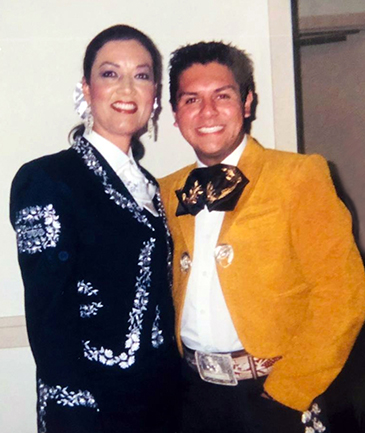
(photo courtesy of Andrés González)
Her illness
In 2008, Laura was diagnosed with scleroderma, a rheumatic autoimmune disease that causes a hardening of the skin and tissues. Although she knew that this would eventually impair her ability to play the violin, she was determined to continue her normal activities as long as she could. That same year she accompanied Mariachi Mujer 2000 to Beijing, China, where they performed for the Olympics and where Laura climbed the Great Wall of China.
Laura’s health deteriorated slowly but steadily. Marisa Orduño, director of Mariachi Mujer 2000, recalls:
I had noticed her abilities deteriorate for some time, but I didn’t want to say anything. One day she came up and confessed everything to me, crying. I asked that if she couldn’t continue playing with the group, would she please at least keep directing us. Laura continued attending the group’s performances and directing from the wings until just a few months before her death.
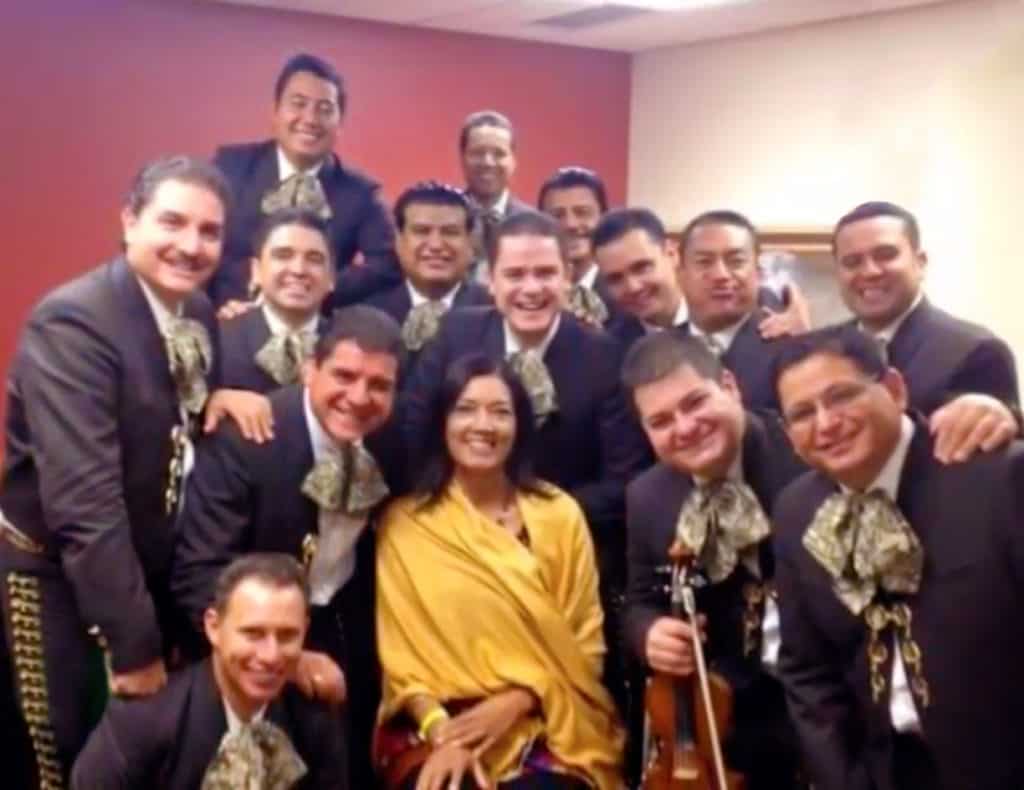
Front row: Steeven Sandoval, Ángel Martínez, Laura Sobrino, Carlos Martínez, Eduardo Ponce. Center row: Fernando Martínez, Óscar Arellano, Daniel Rosales, Alejandro Martínez, Edwin Origel, Moisés Vargas, Marcos López. Back row: Francisco Aguilar, Roberto Hernández, Manuel García.
(photo courtesy of Nancy Muñoz)
Laura the manager
Another activity of Laura’s worthy of mention is that of artist manager. During the last two years of her life, she managed Mariachi Nuevo Tecalitlán in U.S. concerts and festivals. She also managed singer Juan Mendoza “El Tariácuri.”
Ángel Martínez, director of Mariachi Nuevo Tecalitlán, comments:
She was truly in love with music, committed to authenticity and traditional style, and totally professional in her work. She taught us a great deal about how to work in the United States.
Juan Mendoza “El Tariácuri” recalls:
Laura was devoted to her music in a way that I’ve seldom seen, and she was highly respected by Mexican musicians. When I found out she was representing Nuevo Tecalitlán, I asked her, “Hey, why don’t you represent me, too? I need someone like you!” She got me work in Albuquerque, Tucson, San Diego, San Juan Capistrano… and it was her idea that I record “La Derrota” for the Mariachi Channel. She was a warrior of Mexican music as well as its preservation and perpetuation. Words can’t express how much I miss her.

(photo courtesy of Juan Mendoza)
Legendary video sessions
One of Laura’s final projects was a historic series of live recordings that Mariachi Nuevo Tecalitlán and Juan Mendoza made at San Francisco’s Hyde Street Studios for the Mariachi Channel. Arturo Gastelum, founder of the Mariachi Channel, tells the story:
I will forever call that production “Laura’s baby.” If it wasn’t for her, those videos would never have been made. To this day, they are some of the most watched mariachi videos on YouTube, and they have a cult following. “A Los Cuatro Vientos” performed by Steeven Sandoval, who was still part of Nuevo Tecalitlán at that time, has reached 5 million YouTube views organically, meaning we didn’t invest money into promoting them. None of this would’ve happened if not for Laura Sobrino. ¡Que viva “La Grandota”!
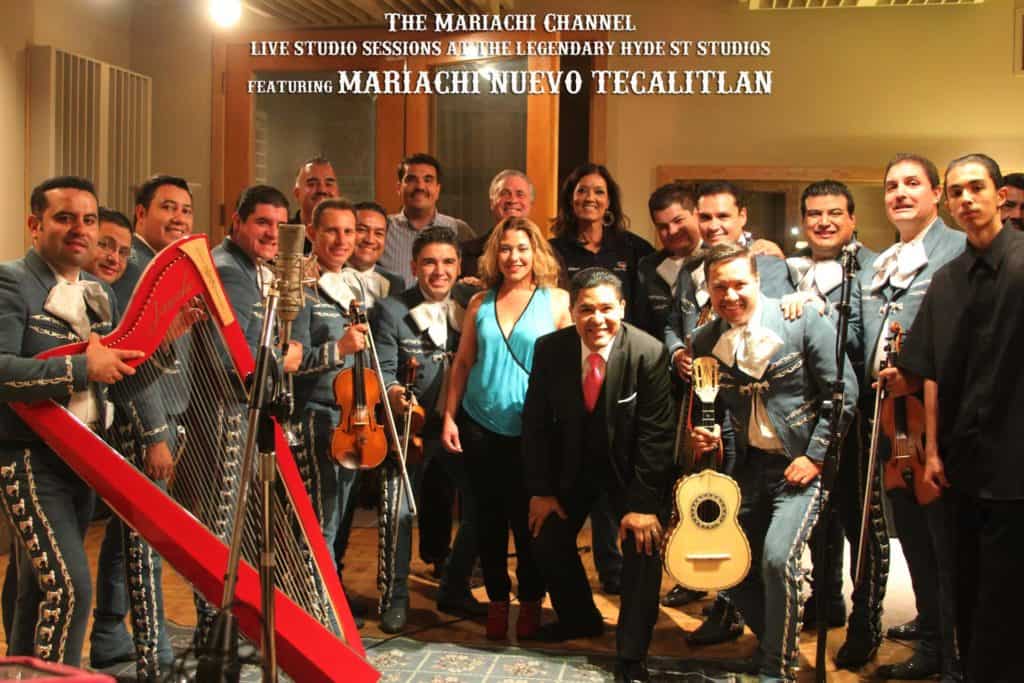
Front row: Marcos López, Eduardo Ponce, Francisco Aguilar, Ángel Martínez, Steeven Sandoval, Moisés Vargas, Óscar Arellano, Carol Téllez, Richard Carranza, Roberto Hernández.
Back row: Raymundo Coronado, José Ballín, Jonathan Clark, Laura Sobrino, Carlos Martínez, Edwin Origel, Daniel Rosales, Fernando Martínez, Arturo Gastelum Jr., Manuel García.
(photo courtesy of Arturo Gastelum)
At the now-legendary Hyde Street Studio sessions in June-July of 2014, Laura was driving Mariachi Nuevo Tecalitlán’s van around the streets of San Francisco wearing an oxygen mask, with her oxygen tank at her side. A month later at Mariachi Spectacular de Albuquerque, where Mujer 2000 and Juan Mendoza performed, she was apparently still going strong, doing all the tasks a manager and musical director would normally do with her oxygen tank as her permanent companion. She was so determined not to slow down that the severity of her condition didn’t really sink in for many of us. I guess we thought she would just keep going indefinitely.
By early 2015, Laura had become less communicative, and I heard rumors that her health was deteriorating rapidly. By spring I had become concerned by her silence, and on May 20th of that year I wrote the following message to Ángel Martínez of Mariachi Nuevo Tecalitlán:
Have you heard from Laura Sobrino recently? The last time I asked you, you said she was okay, but now she doesn’t answer her phone or e-mail, and she hasn’t posted anything on Facebook for some time.
Ángel wrote back saying that he was also concerned by her silence, and asked me to let him know if I found out anything. It was then that I remembered I had the telephone number of Nancy Muñoz, Laura’s best friend, whom I called the following day.
Nancy informed me that Laura had been in the hospital for several months, but that she didn’t want anyone to know about it. The doctors had given her only a few more days to live, Nancy said. That night, May 21, 2015 at 11:38 p.m., our beloved Laura “La Grandota” reunited with her maker. She was 60 years old.
Funeral

(photo by Gilbert Martínez)
Laura’s funeral was probably the most widely attended of any U.S.-born mariachi musician. A moving eulogy by Nydia Rojas was read by announcer José Armando Ronstadt. Juan Manuel Macías, who helped organize the music, recalls:
I posted an announcement on Facebook and called up a lot of compañeros on the phone. About 50 musicians showed up for the wake. The following day, about 80 showed up to play the Mass. Juan Mendoza sang “Ave María” and Suemy González played an unaccompanied solo on Laura’s violin. Outside the church, we played for another hour. It was highly emotional. Both days we played almost exclusively sones, because they were Laura’s passion. Few complete groups attended, but rather individual musicians, male and female, representing the majority of LA-area groups, famous and not-so-famous.
Postlude
In summary, Laura Garciacano Sobrino was a multifaceted luminary of the U.S. mariachi movement—not only as musician, but in the areas of pedagogy, research, direction, and management as well. She was larger than life—not only for her stature, but for her immense heart and relentless drive to perfect her performance skills and inspire others to do the same. By virtue of her passion, kindness and generosity; her gift for discovering and cultivating talent; her vocation for teaching and the selflessness with which she carried out her calling, Laura made a lasting contribution to the mariachi world, particularly to those of the female gender. In the words of her friend and former band member Timoteo “Tello” González: “Everyone wanted to play like Laura. She was the prototypical mariachera and the model to follow for all female mariachi musicians.”

Mariachi Plaza, Los Angeles.
(photo by Nancy Muñoz)

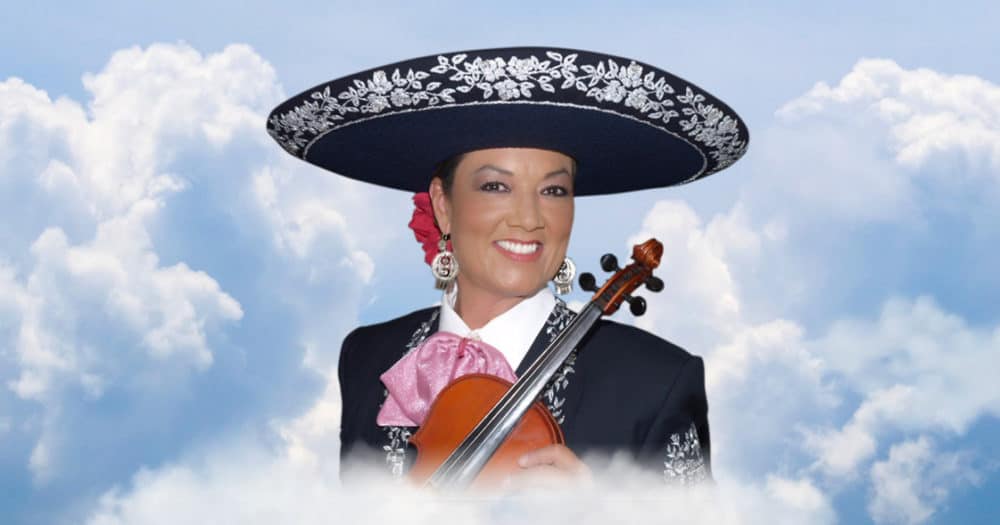





So hard to believe it’s been five years since Laura’s passing. I remember speaking with her during her last year, and she so desperately wanted to attend the Encuentro Internacional del Mariachi in Guadalajara, even if it meant traveling with her oxygen tank. Her passing at age 60 is unfortunate, especially because she left her husband and two beautiful children. Laura will be remembered by many in the mariachi community for the love and passion she had for mariachi music and the many people she touched and helped along the way.
Thank you, Jonny, for putting the spotlight on a more than deserving person who in the big picture of mariachi history has put in quite a few — or buckets — of sand in preserving a foundation of knowledge and growth for the genre. She is truly missed and she will definitely be kept alive through our great memories of her as well as her body of work and recordings. We had big plans for future mariachi productions, and I will live up to as many as possible in her memory and tribute. She’ll definitely be smiling from Heaven later this year when we produce a full album with Mariachi Nuevo Mujer 2000. We’ll always cherish the memories and friendship of La Grandota!!!
I had no idea that Laura was the person who initiated all of those beautiful videos with Nuevo Tecalitlán. Ya’ll did some great work together Arturo — you and Laura. Stay safe and thanks for reading!
I’m her cousin Joe Garciacano, and we grew up together in Watsonville. Reading this article, I learned things that I never knew about my cousin Laura. Thanks for sharing and keeping her memory alive. I still can’t believe that she’s been gone for 5 years.
¡Viva Laura!
I can’t believe it, either. It seems like just yesterday that I spoke with her over the phone. Crazy how time passes and how memories stay with us forever. She was special to many. Please share this with her family — especially her children, if you can. Thanks and stay safe!
One of the projects that Laura was fundamentally crucial to was the recording of Las Pioneras de México in the DF in 2014. I was hired to produce an album of the artists appearing in the German film “Qué Caramba Es La Vida”, which were primarily the venerable women of Las Pioneras. The women insisted that we bring Laura down from LA to work on the album, and I can safely say that we could never have done this album without her.
Laura’s knowledge of the music, her close relationships with the women and other musicians who appeared on the recording and her impeccable standards made her a perfect partner — indeed she was my mariachi guru! We also became very close during that time, sharing a hotel room, telling girl stories, etc. She was increasingly ill and had to bring an oxygen tank into the studio but she was still able to play.
After that we were able to bring Las Pioneras de México to SXSW in Austin in March 2015 where the group showcased and the film premiered. Her doctor would not permit her to come but she engineered the whole trip from her home, bringing in Pat Fernandez, Susie Garcia and Bobbie Garcia, incredible women mariachis, along with Tony Covarrubias, who introduced Laura originally to the women of Las Pioneras. The album is out, it’s available on Spotify, Apple Music and all the rest.
I’m very proud of the work we did together. I miss her terribly, even though I only knew her for one year. I went through the same process of realizing that I hadn’t heard from her for awhile. I had a bad feeling and contacted Susie Garcia who told me she had just passed.
Laura’s funeral was one of the most unforgettable and great experiences of my life. To see her honored by so many was gratifying but it didn’t really take away the pain. She was one of a kind, a true queen, and we should never forget her.
Thank you so much for the article on Laura. I was the publisher/editor of Mariachi Magazine, which I started in 1994 with no previous experience in the field. I was just a big mariachi fan, but started the magazine because I felt some form was needed to disseminate mariachi information, particularly a schedule of events.
Laura was the first person to contact me and offer assistance. She was very excited about my project and offered advice and words of encouragement. She introduced me to many key people in the mariachi genre. She also would inform me whenever an event was coming up, and would invite me to attend. We became good friends, and my daughter Crystal even became the babysitter for her two small children, Nicté and Nazul. She took my daughter everywhere, to the point that my daughter got to know more mariachis than I did.
I am proud to have been able to count myself as one of Laura’s friends and will forever be grateful for all the help and support she gave me when I was struggling to start my project. Some of my photos even appeared in your article today. She is gone, but will never be forgotten.
Congratulations to Jonny Clark for assembling and publishing this remarkably detailed, well written, and fully researched biography of a much loved and respected California born and raised mariachi violinist who apparently touched and inspired a lot of very regional musicians and friends, as well as extended family members, throughout her unfortunately short but fully-lived career. Just collecting these over 22 remarkable photographs must have been a daunting and time-consuming task! I salute this local mariachi historian.
May she rest in peace, surrounded by the best music to which she dedicated her life.
Laura touched many lives and guided the trajectory of so many musicians. Her legacy lives on.
Señor Clark,
Eres un mariachero completo, and to take the time to write such a comprehensive biography of a true legend of mariachi music makes you exactly that. You’ve loved the genre most of your life, and it’s only fitting that you be the one to illustrate the full scope of her contribution to all of us who love that music and were fortunate enough to have known and admired her. Her contributions go well beyond the enjoyment of her music. They touched so many children aspiring to be true mariachis.
As president of the Mexican Heritage Corporation, I saw her influence on our young children, and that moved me more than the great concerts we produced.
Thank you so much, Jonny.
Mi querido Jonathan:
I don’t know very many Mexican mariacheros who are more Mexican than you, amigo. You wrote a loving tribute to Laura Garciacano Sobrino, and it could only have been written by someone who truly loves the genre of mariachi music as deeply as you do. While I only saw her in a couple of performances while we held the mariachi festivals in San José, she clearly was a talented and amazing person. How tragic that illness took her when she still had so much to give. Thanks for sharing this article.
Con mucho cariño amistoso,
Fernando Zazueta
Founding Chairman (retired), Mexican Heritage Corporation
President, La Raza Historical Society of Santa Clara Valley
Thank you for this history lesson on such a beautiful and talented legend. As a mariachi groupie, I recall visiting many of the venues shared in this memorial and listening to these great groups. I was always amazed by Laura’s presence, style, talent, and confidence. She was definitely one of a kind and is missed dearly. God bless you, Laura.
Descanse en paz, maestra. Primero le conoci en Wenatchee, Washington; irradiaba con sabiduría y benevolencia. Luego dio clases de violín a mi hija en Albuquerque en el año 2009. Finalmente, pude consultar con ella cuando me pidieron que iniciara un curso de mariachi localmente. Fue un honor conocerle, aunque brevemente. Pero la vida es solo un momento, ¿no?
Felipe Guzmán
Hi, Jonathan — Just read your beautifully written memorial article on Laura’s life. I loved all the photos. Very historical, and a wonderful biography. She was my first mariachi violin mentor so many years ago. I arranged a one-day seminar with her in 2013, at UC Santa Cruz, for our group. I could tell she had a low energy level then, as she did not stand and play much. It was two years before her passing.
Please keep writing; you seem to be a gifted journalist. Thanks again for a lovely remembrance of Laura.
— Linda Meneken
Jonathan,
What a tremendous tribute to a remarkable woman. Of course it is your work that would so beautifully document Laura’s life and impacts. She was a force of nature. I remember my first meeting with her at our conference. She was tough at first but then once she decided I was a good person, worthy, her personality opened up and her warmth, kindness and talent came forward. I believe I knew her for eight years before she passed. Even in her decline, her dedication to our culture and music was a great thing to see. I am glad we had a chance to know one another. I am also glad she is a part of our Hall of Fame here at Mariachi Spectacular de Albuquerque. We hope a respectful acknowledgement for a woman who led such a transformative life. Her sixty years on earth, she spent well.
I’m Marisa Orduno’s Felicia Marie Gallegos. I met Laura during a visit to Montebello, CA. Mariachi Mujer 2000 had a practice and the tail that I was of course I had to be stuck to Marisa like glue and had the opportunity to meet all the wonderful musicians.
I remember one memorable thing about that day. There was a song that made me cry, and it was sung by Laura. That’s how I remember which musician she was.
Tuve el gran honor de escucharla tocar y cantar en muchos lugares en Santa Cruz. Años depués, nos encontramos en Cielito Lindo una vez más. Aún puedo sentir el poder de su voz y el encanto de su ser.
Qué no hiciera para regresar a verla tocar y cantar. ¡Ella me hizo sentir tan especial!
I read your article with great interest as I remember Laura from the early days at UC Santa Cruz in David Kilpatrick’s Music of Mexico class we both were in. I, too, was part of the inaugural UCSC student mariachi on campus in spring of 1975. I joined as the female trumpet player that year and continued until after my graduation in 1977. Laura was an amazing musician and performer then, and obviously continued that beautiful career until her passing. Thank you for your wonderful article highlighting her outstanding career and life. The mariachi world lost a beautiful talent, but heaven is enjoying her sweet, energetic voice among the angels.
I knew Laura since high school and were friends. At that time we met, she was playing the violin in orchestra and I was in the band class. We met again years later and she had told me she found her ‘roots.’ She said she was listening to certain radio stations and she was relearning Spanish again. As she explained it to me, was an easier way of becoming more comfortable with the words as well as the pronunciation. Laura started playing the violin along with the radio. After that, she practiced, she learned, she excelled as she always did in everything she did in her life. Laura became the wonderful person we all will remember for her musical talents, friendship, and expertise. She was always proud of her upbringing, her love for her mother, and of course her love of her family. Even when she learned the obstacles that were ahead all during her adult life, Laura bravely accepted what the future had in store for her; and she took it in stride. Laura left behind her scores of those who will always remember her in their lives.
Many years ago when Laura played with Sol de Mexico, I owned a sewing factory and she was planning to go on vacation and asked if I would help her with making a wardrobe for her. We went shopping for fabrics and she chose styles she liked. After a few weeks she was ready for her vacation with a new wardrobe. That’s one of my fondest memories with her.